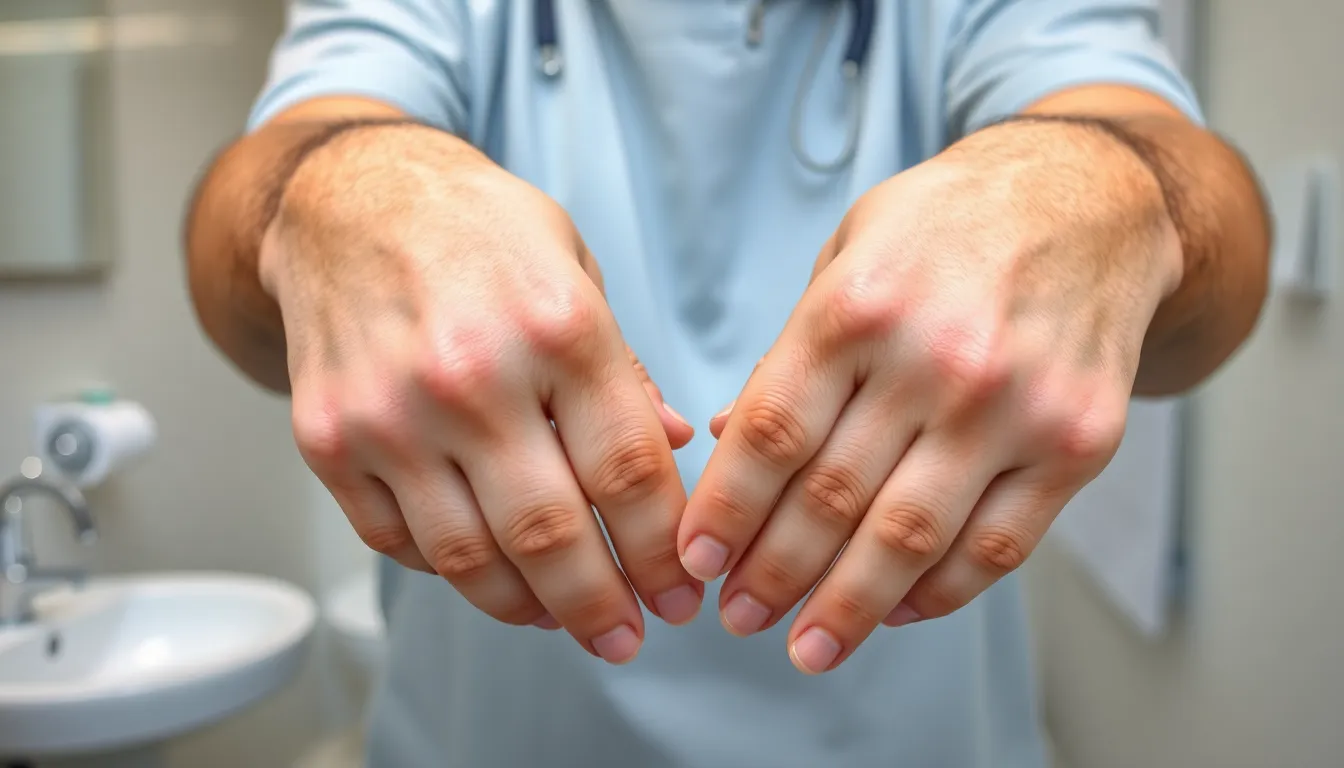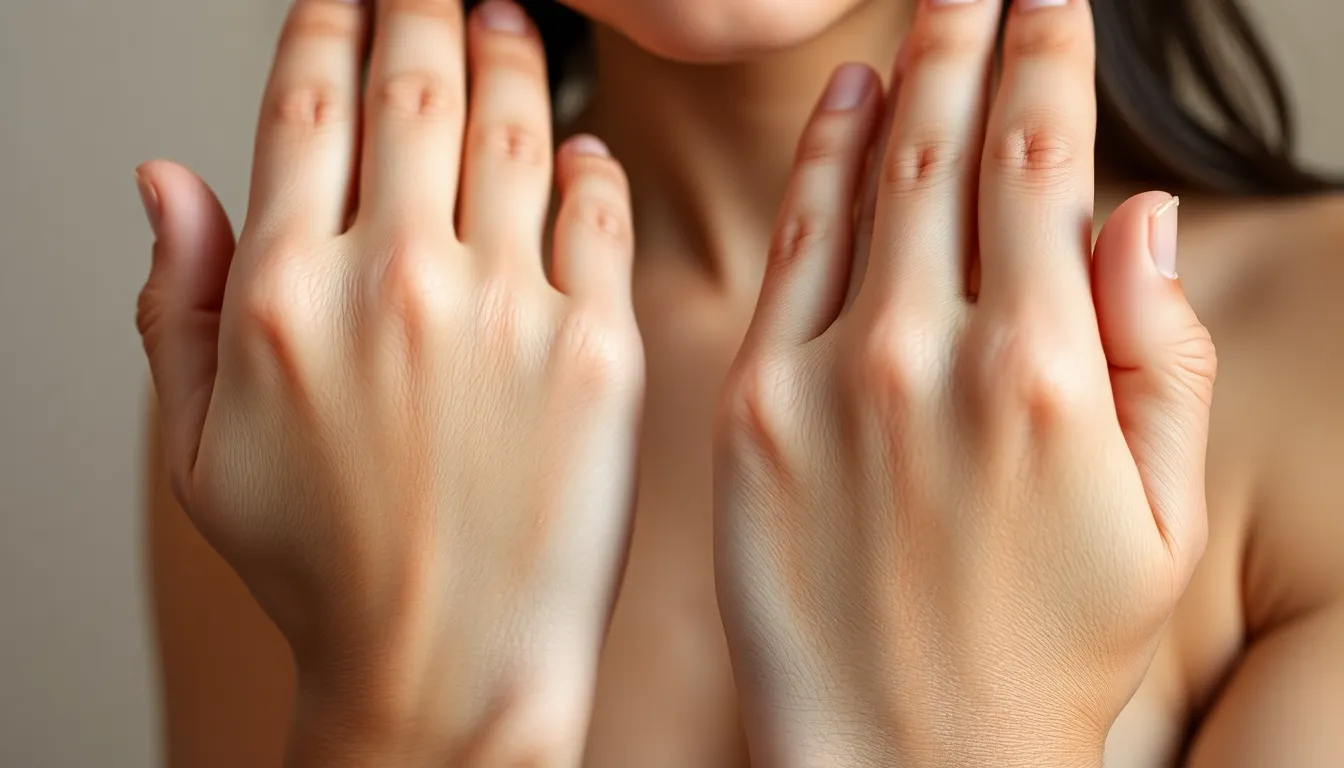Ever looked down at your hands and thought, “What in the world are those tiny bumps?” You’re not alone. Many people encounter these mysterious little guys that pop up without warning, and the best part? They’re not itchy! It’s like they decided to crash the party without bringing any drama.
Table of Contents
ToggleSmall Bumps on Hands Not Itchy: Overview
Small, non-itchy bumps on hands can arise for various reasons. These bumps can differ in size, color, and shape. Often, they appear suddenly without any associated irritation or symptoms. Various factors, including skin conditions, environmental exposure, and infections, can lead to this phenomenon.
Common causes include keratosis pilaris, a benign condition that results in small, rough bumps due to skin cell buildup. Another possible cause is pompholyx, characterized by small blisters that may not itch. Individuals may also experience milia, which are tiny white cysts often found on the skin’s surface.
Contact dermatitis might contribute to the appearance of such bumps. When the skin contacts harsh substances, small bumps can form even without itching. Infections, although rarer, can also result in small non-itchy bumps on the hands.
Lifestyle factors play a significant role. Stress, diet, and environmental irritants can lead to skin changes. Individuals experiencing persistent or worsening bumps should consult a healthcare professional for proper evaluation and guidance.
Overall, these small bumps typically pose no health risks. They do not signify a serious underlying condition. Understanding the potential causes can help individuals manage their skin health and seek appropriate care when necessary.
Common Causes

Small, non-itchy bumps on hands can arise from various factors. Understanding these causes allows individuals to manage their skin health effectively.
Allergic Reactions
Allergic reactions can lead to bumps on the skin. Substances like nickel, fragrances, or certain plants may trigger this response. These bumps typically appear suddenly after contact with allergens. While they may not itch, they can cause swelling or redness. Identifying and avoiding the specific allergen can help prevent future occurrences.
Skin Conditions
Skin conditions frequently result in small bumps on hands. Keratosis pilaris, for instance, manifests as tiny, rough bumps and is harmless. Pompholyx presents as small blisters or bumps and often occurs during stress or heat. Milia, which are small white cysts, can also appear without discomfort. Consulting a dermatologist can provide clarity on these conditions and assist in finding effective treatments.
Environmental Factors
Environmental factors play a significant role in skin changes. Frequent handwashing with harsh soaps can lead to irritation and bumps. Sun exposure can cause skin texture changes, and dry weather might exacerbate these issues. Individuals who frequently handle chemicals or irritants may notice similar bumps develop. Taking protective measures, such as wearing gloves or using gentle cleansers, can minimize these environmental impacts.
Diagnosis and Treatment
Individuals noticing small, non-itchy bumps on their hands should seek a proper diagnosis to rule out underlying conditions. Consulting a dermatologist often proves beneficial, as they specialize in skin issues. A thorough examination allows for accurate identification of bumps, which can inform appropriate treatment options. Medical professionals may recommend a biopsy for persistent or suspicious bumps to gain further insight into their nature. In cases related to allergic reactions, identifying the trigger can lead to more effective management strategies.
Seeking Medical Advice
Consulting a healthcare professional is crucial when persistent bumps appear. Dermatologists evaluate the bumps and consider factors like size, shape, and patient history. Individuals should communicate details clearly, especially if bumps change over time. Appropriate diagnosis can lead to targeted treatments, which may include topical medications or lifestyle modifications. In addition, if new symptoms accompany the bumps, such as pain or swelling, immediate medical attention is essential for further evaluation.
Home Remedies
Using home remedies can also provide some relief for small bumps. Applying aloe vera gel may soothe the skin and promote healing. Natural oils, such as coconut oil, possess moisturizing properties, which can reduce roughness. Gentle exfoliation with a mild scrub might help remove dead skin cells that contribute to bump formation. Keeping hands moisturized with fragrance-free lotions prevents dryness, which can exacerbate skin issues. Individuals could also consider incorporating an oatmeal bath into their routine to calm irritation and support skin health.
Prevention Tips
Taking proactive measures can help minimize the occurrence of small non-itchy bumps on hands. Implementing a suitable skincare regimen and avoiding irritants plays a vital role in maintaining skin health.
Skin Care Routine
Establishing a consistent skincare routine is essential. Use gentle cleansers to avoid stripping the skin of moisture. Follow up with moisturizers that contain hydrating ingredients, like glycerin or hyaluronic acid. Regular exfoliation helps remove dead skin cells, preventing clogged pores. Incorporating natural oils, such as jojoba or almond oil, nourishes the skin while providing a protective barrier. Lastly, applying sunscreen protects against UV damage.
Avoiding Irritants
Identifying and avoiding irritants is crucial for maintaining healthy skin. Frequent handwashing can lead to dryness, so selecting mild, fragrance-free soaps is beneficial. Wearing gloves while handling cleaning products or chemicals prevents contact dermatitis. Choosing natural fabrics for gloves or clothing reduces the risk of allergic reactions. Additionally, being mindful of using personal care products that contain synthetic fragrances or allergens will further protect the skin.
Small bumps on the hands can be concerning but are often harmless and non-itchy. Understanding their potential causes helps demystify this common skin issue. From keratosis pilaris to contact dermatitis, various factors contribute to their appearance. With the right preventive measures and a consistent skincare routine, individuals can manage these bumps effectively.
For those experiencing persistent or concerning symptoms, consulting a dermatologist is crucial. A professional evaluation can provide clarity and inform the best treatment options. By staying informed and proactive about skin health, individuals can maintain healthy, comfortable hands.








